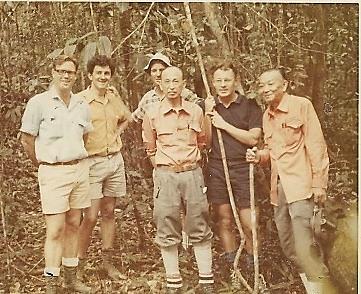
2 minute read
Further Domestication of PNG’s Indigenous Forest Species
from PNGAF MAG ISSUE # 9D-5B4T2 of 21st Aug 2022 Eminent TPNG Forester Dr Bob Thistlethwaite 1971-1975
by rbmccarthy
FURTHER DOMESTICATION OF PNG’S INDIGENOUS FOREST SPECIES
Paper submitted by Dr Robert Thistlethwaite 20/12/2019 Domestication of indigenous species is certainly the correct approach to plantation establishment in PNG, rather than relying on exotic species with which local people have no familiarity. Early plantation activity in PNG did rely on local species, Hoop Pine, Klinkii Pine and Kamarere. The introduction of Teak was an aberration in this regard, but understandable when directed to the strongly dry monsoon area near Mt Lawes, inland of Port Moresby. However, the establishment of plantations of Teak at Kerevat was less apt when many other domestic species could have been used. The Kerevat plantations were based on the performance of early introductions of Teak in the late 19th and early 20th centuries by the Germans from Myanmar for trial plantings at Alexishafen near Madang and Kokopo near Rabaul. The Kerevat plantations, which included Kamarere, Teak, Balsa and trials of other species were grown on an area which came under strong land dispute (Baining) and large areas have been cleared for gardens. They are no longer controlled by the Government.
Advertisement
There was also some work undertaken on the domestication of Terminalia brassii and trial plantings were made both at Kerevat and at Baku on the Gogol River. T. sepicana was also evaluated along with some exotic Terminalia spp but proved (at Kerevat) quite susceptible to white ant attack. T. brassii performed satisfactorily, but there was nothing at the time to recommend it over Kamarere. However, it is well to note that there are two forms of T. brassii. One form has good form and no stilt roots, while the other has a more variable form and had stilt roots with lenticels. The stilt root variety grew in swampy ground. As I recall, the stilt root variety came from the Jaba River area of Bougainville, but I have found no information on what may have survived mining activity at Panguna. The variety without stilt roots came from Buin.
Baku Forest Station 1971. Photo credit Ian Whyte.
There were small trials of Intsia bijuga, which proved very slow growing at Baku. There are several E. tereticornis provenances in PNG and some were used in trials, along with E. brassiana. Neither proved particularly promising over other species. However, in the Efogi/Launumu area (on the Kokoda Track), and at Buna/Gona/Dobudura Grasslands (Popondetta area), E. tereticornis was prized as a house post.
Anthocephalus chinensis (Labula) was grown in trial plantations at Baku on the Gogol River, quite successfully, although as would be expected with such an aggressive primary colonizer, its initial very high rate of growth tapered off as the plantation matured. Once established, a restriction of side light from competing vegetation, such as bananas, did not worry Labula.








